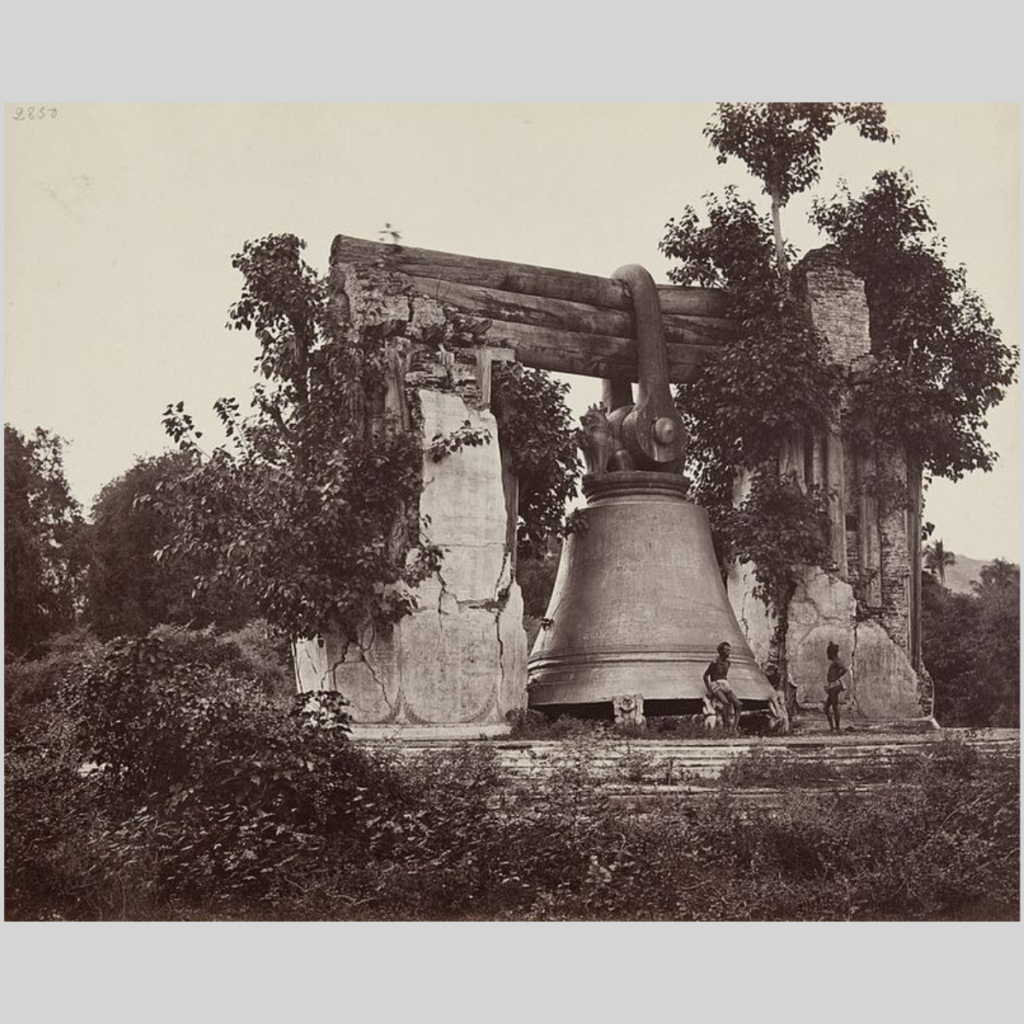
The Mengoon Bell, Mandalay, Burmah. From a photograph by Captain Edward B. Sladen.

Article accompanying the illustration
Burmah is a country in which the historical value or importance of bells is only surpassed by their universal use and apparently religious connection with the rites and ceremonies of Buddhism. Almost every temple, or rather pagoda, is provided with a bell, which is reverentially struck by each of the several votaries at the particular shrine, previous to the offering up of prayers, with a view to its being noised abroad generally in the material and spiritual world that the suppliant is willing to share the after rewards to be derived, as the merit of his prayer or offerings, with all the rest of mankind.
The Mengoon bell is situated on the right bank of the Irrawaddy, almost opposite to the present Royal city of Mandalay. Its weight is 195,000 lb., calculated according to the quantity of metal need in the casting, and its extreme height and breadth (that is to say, the height and breadth of the bell proper) are respectively 21 ft. and 8 ft.; so that, as regards size and weight, it ranks amongst the most remarkable bells in the world. It is suspended on three massive round logs of teak, placed horizontally and longitudinally, the one over the other, their ends resting on two pillars of vast size, composed alternately of masonry and large upright teak posts. These pillars are becoming dilapidated. The three teak logs, too, from which the bell is suspended, have, nautically speaking, it will be seen, “taken a list,” not to port, but amidships, and sensibly acknowledge the stupendous burden under, or rather above, which they labour. This bell was cast about seventy-five years ago, in the time and under the superintendence of King Bo-Do-Piyah, the great-grandfather of the present ruling Sovereign of Burmah. Bo-Do-Piyah’s reign is famous in the history of Burmah as having extended over a period of thirty-six years; and his memory is still revered as the Sovereign during whose time the Burmese empire, far and wide, flourished under the genial effects of plentiful and abundant harvests, and by the virtue of whose almost supernatural power its limits extended to distances never before attained.
Near the bell is a pagoda of prodigious size, also erected by the same Monarch at about the same time as he interested himself in the casting of the famous bell. The pagoda is a square brick building of solid masonry, and measures in length on each side 150 yards. It rises in this square form, and with almost imperceptible diminished proportions, to a height of 150 ft., when the work seems suddenly to have been arrested. It has not escaped the effects of earthquakes, which, from time to time, have been so ruinous to masonry building in Upper Burmah. Several large cavernous fissures appear in various parts in its side, from top to bottom, and may be said to hold out to sacrilegious explorers a rather tempting road to wealth; that is to say, if credence is to be placed in the alleged fact that within the solid masonry of the building lie entombed one hundred mages of solid gold, of lifesize, each image representing one of the I bers of King Bo-Do-Piyah’s family. The story relates that the members of the Royal family (most probably sons and daughters only) amounted to ninety-nine, and that the King was obliged to adopt one child into his household to make up the round number of one hundred.
Our Engraving of the bell is from a photograph obligingly forwarded to’us by Captain Edward B. Sladen, British Agent at the Court of Mandalay.